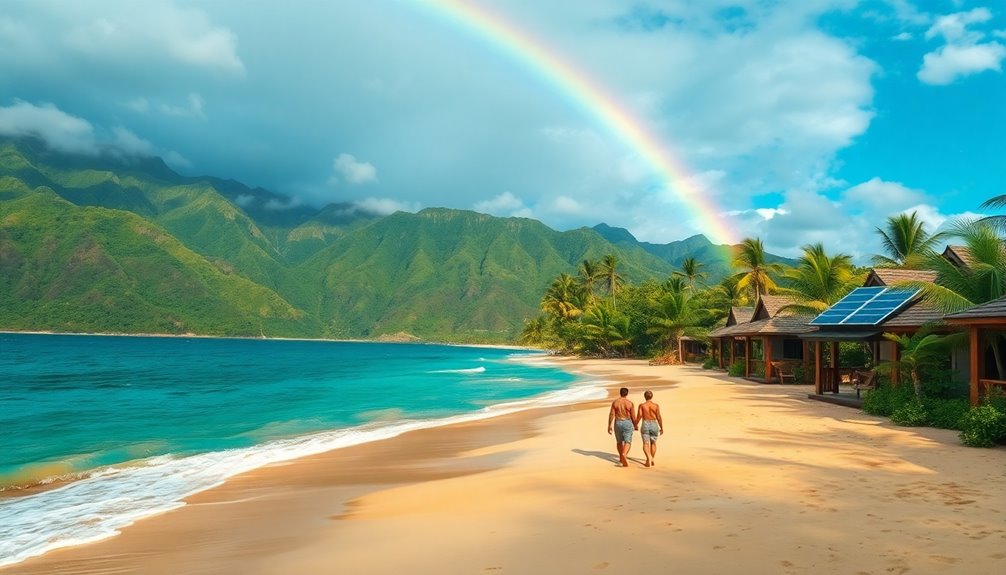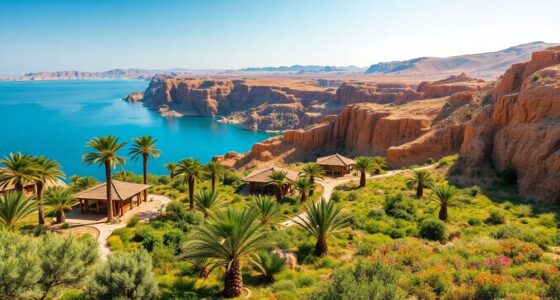Hawaii's sustainable tourism revolution is all about you enjoying eco-friendly getaways while preserving the islands' unique beauty. From direct flights that minimize your carbon footprint to public transportation options once you land, it's easier than ever to travel sustainably. Explore vibrant local farmers' markets and support native artisans, which directly benefits the community. Participate in wildlife tours that respect marine life and involve you in conservation efforts like beach clean-ups. Enjoy breathtaking natural landscapes while also making a positive impact. Stick around, and you'll discover even more ways to make your Hawaiian adventure truly sustainable.
Key Takeaways
- Hawaii boasts unique biodiversity and ecosystems, with sustainable tourism practices aimed at preserving its native species and habitats.
- Eco-friendly travel options, like direct flights and public transit, help reduce carbon emissions for tourists visiting the islands.
- Responsible wildlife observation and conservation-focused tours allow visitors to engage with local ecosystems while minimizing their environmental impact.
- Supporting local economies through farmers' markets and artisan crafts fosters cultural connection and promotes sustainability in tourism.
- Educational initiatives and workshops enhance awareness of eco-friendly practices, encouraging tourists to adopt sustainable habits during their stay.
Introduction
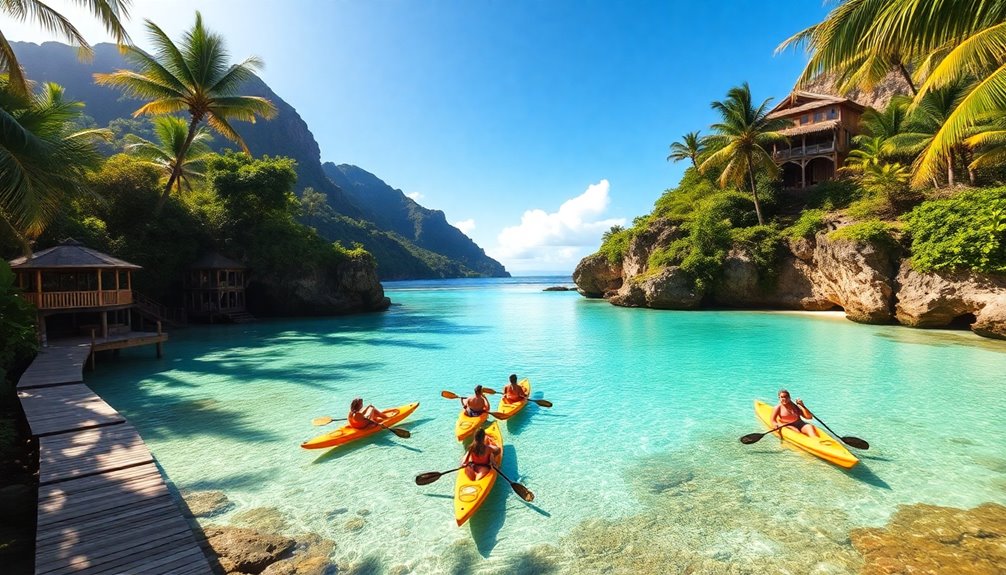
Hawaii's stunning landscapes and rich biodiversity make it a tropical paradise worth exploring.
As you discover its unique ecosystems, you'll see why preserving this beauty is crucial for future generations.
Embracing sustainable tourism allows you to enjoy Hawaii while contributing to its conservation efforts.
Tropical Paradise and Biodiversity Hotspot
Nestled in the Pacific Ocean, this tropical paradise boasts over 10,000 species of native plants and animals, many of which you won't find anywhere else on Earth.
Hawaii's unique geographical isolation has fostered an incredible biodiversity, making it a must-visit for ecotourists. Here are three highlights of Hawaii's diverse ecosystems:
- Lush rainforests teeming with endemic species
- Dramatic volcanic landscapes rich in flora
- Pristine coral reefs that support marine life
Hawaii's commitment to sustainable tourism ensures these delicate ecosystems are protected.
By promoting responsible travel practices, you can help maintain the islands' natural beauty while enjoying their unique offerings.
Embrace the opportunity to explore this biodiversity hotspot and contribute to its conservation efforts.
Preserving Hawaii's Unique Ecosystems
While exploring Hawaii's breathtaking landscapes, you'll discover just how crucial it's to preserve its unique ecosystems. Home to over 25,000 species found nowhere else, Hawaii's diverse habitats—from lush rainforests to vibrant coral reefs—are incredibly vulnerable.
Threats like invasive species, climate change, and pollution highlight the need for urgent conservation efforts. By embracing sustainable tourism practices, such as responsible snorkeling and wildlife viewing, you can help minimize human impact on these fragile environments.
Choose eco-friendly accommodations and activities that support local economies while conserving natural resources. You can also engage in beach clean-ups and use reef-safe sunscreen to protect Hawaii's marine ecosystems.
Together, we can ensure these wonders endure for generations to come.
Travel From California to Hawaii
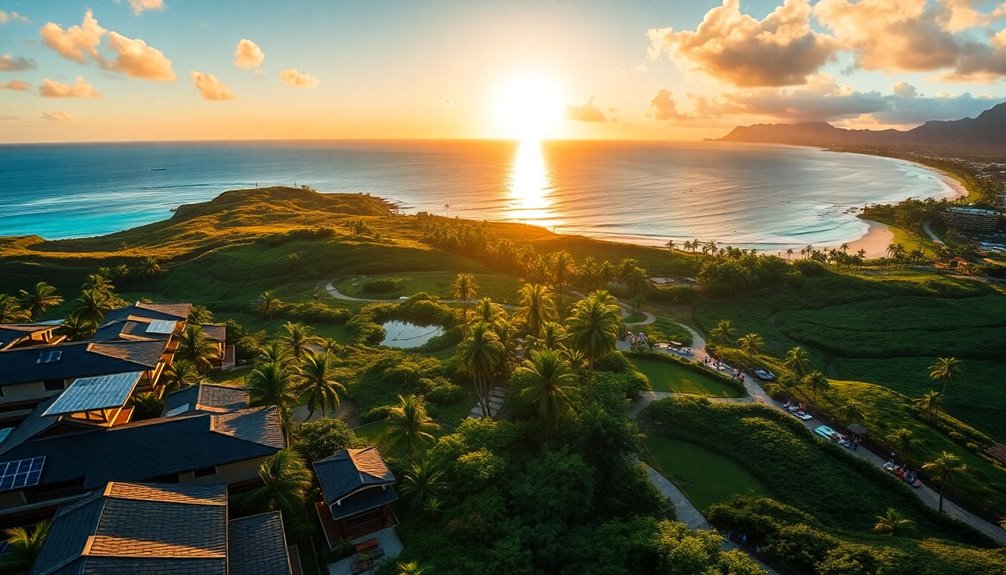
Traveling from California to Hawaii is a breeze, with direct flights taking just 5 to 6 hours.
You can choose from several airlines that focus on eco-friendly practices, making your trip more sustainable.
Plus, once you arrive, there are plenty of green options to explore the islands while minimizing your carbon footprint.
Travel From Mainland USA
How do you get from California to the stunning shores of Hawaii?
You'll find it easy to plan your eco-friendly vacation with numerous direct flights available from major airports like LAX and SFO.
Here are three key tips to consider:
- Choose Non-Stop Flights: Minimize your carbon footprint by opting for direct routes, which reduce travel time and emissions.
- Pick the Right Airline: Airlines like Hawaiian, Alaska, and United often provide competitive fares and eco-friendly options.
- Pack Sustainably: Bring reef-safe sunscreens and reusable items to support sustainable tourism practices while you enjoy Hawaii's beauty.
With just a 5 to 6-hour flight, you'll soon be immersed in the incredible landscapes and culture that Hawaii has to offer!
Travel From London to Hawaii
Reaching Hawaii from London can be an adventure, taking roughly 11 to 14 hours, depending on your layovers. Major airlines typically connect through cities like Los Angeles or San Francisco, so plan your itinerary wisely.
As you embark on this journey, consider choosing eco-friendly airlines that prioritize sustainable travel practices, including carbon offset programs and fuel-efficient aircraft.
Upon arrival, you'll dive into Hawaii's eco-tourism options, from eco-lodges to sustainable activities, allowing you to enjoy the islands while promoting conservation efforts. Additionally, monitoring market trends can help you stay informed about the best times to travel and invest in eco-friendly experiences.
Keep in mind that Hawaii's time zone is 10 to 11 hours behind London, so adjust your schedule accordingly.
Embrace responsible travel, and you'll create memorable experiences while supporting Hawaii's stunning environment.
Travel From Sydney to Hawaii
Ever wondered how you can make the most of your journey from Sydney to Hawaii? With a flight duration of around 10 to 11 hours, you're in for an adventure!
Here are three tips to enhance your travel experience:
- Book in advance: Secure the best rates, especially during peak seasons.
- Immerse yourself in Hawaiian culture: Learn about local traditions and customs to enrich your stay.
- Support local businesses: Choose to dine at local eateries and shop at small boutiques to truly experience Hawaii's charm.
As you fly over the stunning Pacific Ocean, keep an eye out for marine life.
Your journey is just the beginning of an unforgettable Hawaiian experience!
Public Transit Options Available
While traveling from California to Hawaii primarily means hopping on a plane, there are plenty of public transit options to consider once you arrive in the islands. Major airlines like Hawaiian Airlines, Southwest Airlines, and Alaska Airlines offer direct flights from cities like Los Angeles and San Francisco. Once you land, you can immerse yourself in the local community by using public transit systems such as the Bus in Oahu or the Maui Bus. These eco-friendly options allow you to explore the islands without the hassle of a car. Additionally, utilizing eco-friendly transportation helps reduce your carbon footprint while enjoying the beautiful scenery. Here's a quick comparison of some public transit services:
| Island | Public Transit Options | Eco-Friendly Features |
|---|---|---|
| Oahu | The Bus | Comprehensive routes |
| Maui | Maui Bus | Low-emission vehicles |
| Big Island | Hele-On Bus | Supports local tourism |
| Kauai | Kauai Bus | Community-focused routes |
Sustainable Wildlife Viewing Opportunities

When you explore Hawaii's unique wildlife, you'll find plenty of opportunities for responsible observation and eco-friendly tours.
From sustainable snorkeling in protected waters to lodging options that prioritize conservation, you can enjoy nature while supporting its preservation.
Engaging in these activities not only enhances your experience but also helps maintain the islands' delicate ecosystems.
Responsible Wildlife Observation Activities
Responsible wildlife observation activities in Hawaii offer unique opportunities to connect with the islands' diverse ecosystems while promoting sustainability.
Here are three engaging ways to experience Hawaii's wildlife responsibly:
- Whale Watching: Join eco-tour operators who adhere to regulations, maintaining a 100-yard distance from migrating humpback whales to protect their natural behavior.
- Birdwatching Tours: Participate in guided tours led by certified eco-tour operators, focusing on rare tropical species while respecting their habitats.
- Beach Clean-Ups: Engage in organized clean-ups, enhancing the health of local ecosystems and increasing your chances of spotting marine wildlife.
Sustainable Snorkeling and Diving Tours
Exploring Hawaii's vibrant underwater world through sustainable snorkeling and diving tours enhances your wildlife viewing experience while supporting conservation efforts.
By participating in eco-friendly tours, you're not just enjoying the beauty of marine ecosystems; you're also prioritizing reef conservation. Operators like Fair Wind Cruises promote responsible practices, using reef-safe sunscreens and limiting group sizes to minimize environmental impact.
You'll learn about the delicate balance of marine life, with guidance on maintaining a safe distance from vulnerable species like sea turtles and coral reefs. Many tours include opportunities for beach clean-ups or conservation projects, allowing you to actively contribute to the health of these environments.
Plus, you'll respect regulations that protect majestic humpback whales during their migration season, ensuring ethical wildlife viewing.
Sustainable Lodging Options Available
Although sustainable lodging options abound in Hawaii, they offer more than just comfortable accommodations; they provide unique opportunities for wildlife viewing that align with conservation efforts.
When you choose eco-friendly lodgings, you engage in sustainable tourism that benefits both you and the environment.
Here are three ways to enhance your experience:
- Join guided tours at places like Volcano Eco Retreat, learning about local ecosystems.
- Participate in responsible whale watching with certified operators, ensuring marine life's safety.
- Volunteer for wildlife monitoring and habitat restoration projects in partnership with local conservation organizations.
Additionally, many eco-friendly lodgings often incorporate sustainable materials in their construction and furnishings, promoting a holistic approach to environmental conservation.
Support Local Farmers' Markets

When you visit Hawaii, supporting local farmers' markets offers a unique chance to connect with the community while enjoying the freshest produce the islands have to offer.
These markets feature 80% local farmers, directly benefiting the economy and ensuring you savor organic, locally grown crops. By choosing to shop here, you reduce food miles, which positively impacts the environment.
You'll discover unique Hawaiian ingredients like taro and lychee, enriching your culinary adventure. Many markets also host educational workshops, fostering awareness about sustainable farming practices.
Community-Led Conservation Projects
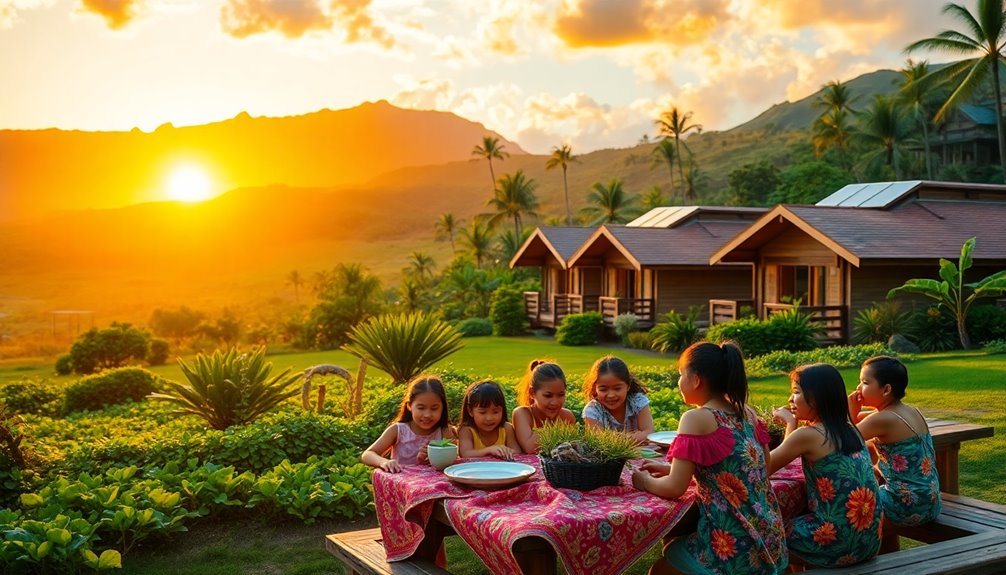
Community-led conservation projects in Hawaii empower you to take an active role in protecting the environment while celebrating local culture.
By collaborating with non-profits and government agencies, you can help preserve vital ecosystems and enhance community pride.
Engaging in these initiatives not only benefits the land but also fosters a deeper connection to your heritage and surroundings.
Government and NGO Efforts
As local organizations team up with state and federal agencies, they're making significant strides in restoring Hawaii's native ecosystems through community-led conservation projects.
These efforts not only protect endangered species like the Hawaiian monk seal but also bring communities together. Here are three noteworthy initiatives:
- The Hawaiian Islands Land Trust aims to preserve over 130,000 acres of vital ecosystems through community engagement.
- The "Malama Hawai'i" program invites visitors to join in conservation efforts, enhancing sustainable tourism experiences.
- The Aloha+ Challenge unites government and businesses to achieve sustainability goals, including a 40% reduction in greenhouse gas emissions by 2030.
Through these collaborative efforts, the focus on conservation fosters a healthier environment and a stronger community connection.
Community and Cultural Sustainability
While preserving Hawaii's unique ecosystems, local residents are stepping up to take charge of their natural resources through community-led conservation projects.
These initiatives empower Native Hawaiian communities to manage their marine and land resources sustainably, fostering a strong sense of ownership. The "Aha Moku" system exemplifies this, utilizing traditional practices and local knowledge to enhance resource management.
Programs like "Kupu A'e" engage youth in hands-on environmental restoration, building leadership skills and community pride.
Collaborative efforts, such as the "Malama Honua" initiative, unite residents in protecting Hawaii's ecosystems through education and active involvement.
Research shows that these community-driven projects not only enhance biodiversity but also improve ecosystem health, proving the effectiveness of local stewardship in Hawaii's sustainable tourism efforts.
Optimal Months for Eco-Tourism
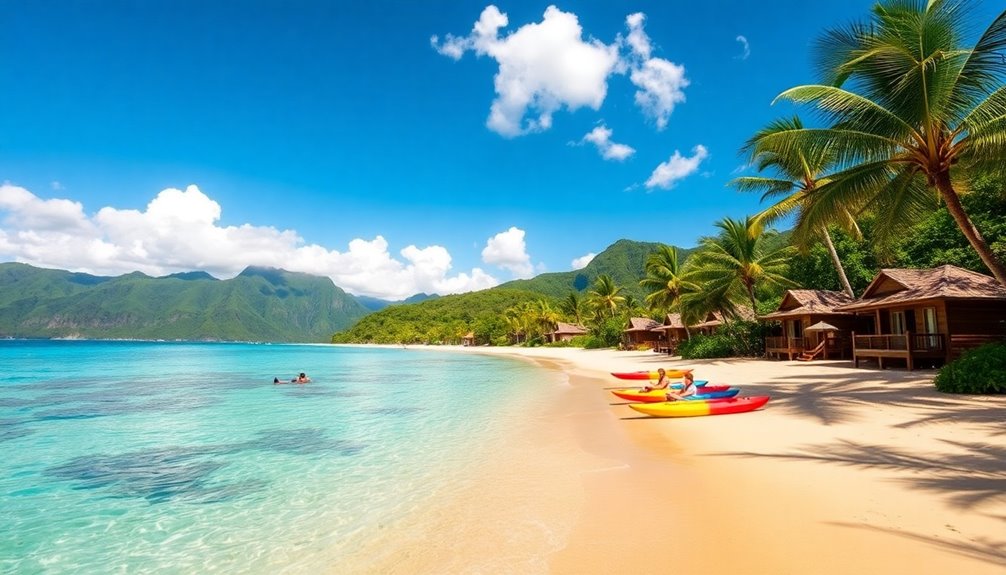
If you're planning an eco-tourism trip to Hawaii, consider timing your visit during the peak whale migration season in January and February for unforgettable wildlife experiences.
However, keep in mind that hurricane season can impact your travel plans, so it's smart to check forecasts before booking.
Peak Whale Migration Season
January marks the start of peak whale migration season in Hawaii, drawing visitors eager to witness humpback whales in their natural habitat.
From January to March, these majestic creatures travel to warm waters for breeding and calving, with January being the prime month for sightings.
Here are three reasons to experience this season:
- Educational Tours: Join eco-tour operators who offer informative experiences about whale behavior and marine conservation.
- Regulated Viewing: Boats must stay at least 100 yards away from the whales, ensuring their protection.
- Support Local Economies: Engaging in responsible whale watching promotes sustainable tourism, benefiting both the environment and local communities.
Additionally, the Big Island, HI provides a stunning backdrop for these experiences, showcasing diverse ecosystems and volcanic landscapes.
Make the most of this incredible season while respecting the majestic humpback whales!
Hurricane Season Impacts Travel Plans
Hurricane season in Hawaii can significantly impact your travel plans, particularly if you're aiming for an eco-tourism experience.
Typically running from June 1 to November 30, the highest likelihood of storms occurs between August and October. To avoid potential disruptions, consider planning your eco-tourism trips during the drier months of April to June and September to November.
Keep in mind that the peak hurricane season might lead to temporary closures of eco-friendly accommodations and tours, affecting your options. Many local eco-tourism operators offer flexible cancellation policies during this time, ensuring you can adjust your plans as needed.
Stay informed about weather forecasts and local advisories to ensure a safer, more enjoyable experience while exploring Hawaii's natural beauty.
How to Make Your Trip More Sustainable
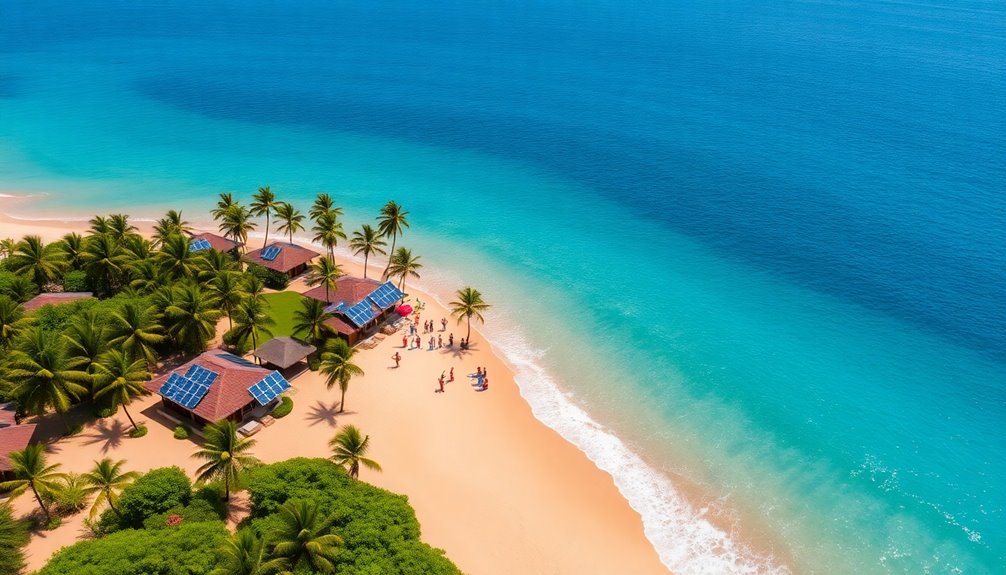
To make your trip to Hawaii more sustainable, start by using reusable travel containers for food and drinks, which helps cut down on waste.
Support local artisans and crafts by purchasing handmade items instead of mass-produced souvenirs; this boosts the local economy and preserves Hawaiian culture.
Every small choice you make can contribute to a more responsible travel experience.
Use Reusable Travel Containers
Using reusable travel containers is one of the simplest yet most impactful ways to make your trip to Hawaii more sustainable.
By choosing to carry these containers, you help reduce single-use plastic waste and embrace sustainable tourism.
Here are three benefits of using them:
- Cut down on plastic: You can save an average of 167 plastic bottles per person every year.
- Minimize food waste: Reusable containers for snacks or meals encourage a healthier approach to consuming local, organic foods.
- Access eco-friendly perks: Many accommodations in Hawaii offer refill stations and discounts for guests with their own containers.
Additionally, incorporating reusable travel containers aligns with the growing trend of circular economy practices that emphasize reducing waste and promoting sustainability.
Support Local Artisans and Crafts
Embracing sustainable tourism in Hawaii goes beyond reducing plastic waste; it also involves supporting the local community. When you support local artisans, you help preserve Hawaiian culture and stimulate the economy. By purchasing handmade crafts like traditional quilts or jewelry, you directly benefit local communities and encourage sustainable practices.
| Artisan Craft | Sustainable Practice |
|---|---|
| Traditional Quilts | Made from eco-friendly materials |
| Handcrafted Jewelry | Utilizes sustainable techniques |
| Local Pottery | Crafted with natural resources |
| Artwork & Prints | Produced using recycled materials |
Engaging with local artists through workshops deepens your connection to Hawaiian heritage. By choosing Native Hawaiian-owned businesses, you're ensuring the continuation of these rich traditions for future generations. Supporting local artisans not only enhances your travel experience but also aligns with sustainable practices that promote economic growth in the community.
Frequently Asked Questions
Does Hawaii Have Sustainable Tourism?
Yes, Hawaii does have sustainable tourism initiatives in place.
You'll find a growing emphasis on responsible travel practices that prioritize local communities and the environment.
By choosing eco-friendly accommodations and participating in community-driven activities, you can contribute to preserving Hawaii's natural beauty.
Engage with local businesses, join beach clean-ups, and attend cultural events to deepen your connection to the islands while ensuring your travel choices positively impact the destination.
Which Tourism Is Known as Eco Friendly Tourism?
When you think about eco-friendly tourism, it's all about responsible travel that minimizes environmental impact and supports local cultures.
You're opting for experiences that prioritize sustainability, like staying at green-certified hotels or choosing eco-conscious tour operators.
This type of tourism encourages you to engage with nature and local communities while promoting conservation.
What Are the 3 Main Areas of Sustainable Tourism Impact?
Sustainable tourism impacts three main areas: environmental, economic, and social.
You'll see that it reduces negative effects on ecosystems, conserves resources, and promotes biodiversity.
Economically, it supports local businesses and enhances community livelihoods.
Socially, it fosters respect and understanding between visitors and residents, encouraging cultural exchange.
How Is Hawaii Eco-Friendly?
Hawaii's eco-friendly approach shows in various ways. You can choose certified eco-tour operators, ensuring your excursions respect local ecosystems.
When you stay in eco-lodges, you benefit from renewable energy and local, organic food. You'll also want to use reef-safe sunscreen to protect marine life.
Conclusion
In a world that often prioritizes convenience over conservation, embracing Hawaii's sustainable tourism revolution feels like a breath of fresh air. By choosing eco-friendly getaways, you're not just escaping the daily grind; you're actively participating in a movement that protects paradise. It's ironic, isn't it? While many flock to Hawaii for its beauty, you'll leave your mark by preserving it. So, go ahead—travel sustainably and let your vacation be a gift to both yourself and the islands.

